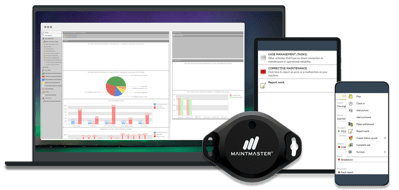Tracking the right Maintenance KPI is essential for optimising equipment performance, reducing downtime, and ensuring cost-effective maintenance operations. Maintenance teams today rely on data-driven insights to shift from reactive to proactive maintenance strategies, improving overall efficiency and asset reliability.
However, different industries prioritise different Maintenance KPIs based on their unique operational challenges. Manufacturing companies focus on equipment reliability and production efficiency, while healthcare facilities emphasise equipment availability to ensure critical medical devices remain operational.
This article explores essential Maintenance KPIs, their applications across various industries, and how the best CMMS software, such as MaintMaster, simplifies KPI tracking and reporting.
Tracking equipment reliability through Maintenance KPIs
Number of Unplanned Stops
Unplanned stoppages measure the frequency of unexpected equipment failures that disrupt production. These stops can be caused by mechanical breakdowns, software malfunctions, or operational errors. Monitoring this Maintenance KPI helps maintenance teams identify patterns and take preventive actions to minimise unexpected downtime.
Unplanned stops are particularly relevant in industries that depend on uninterrupted operations, such as manufacturing, logistics, and power generation. In a manufacturing plant, frequent unplanned stoppages may indicate that preventive maintenance is inadequate. A food processing facility, for instance, identified that lubrication schedules were not optimised. By implementing predictive maintenance, they reduced unexpected failures by 35 percent.
The best CMMS software, such as MaintMaster, helps track unplanned stops in real time. By automatically logging failures and providing detailed reports, it enables maintenance teams to analyse trends and take proactive steps to prevent future breakdowns.

Immediate Corrective Maintenance Ratio
This KPI measures the proportion of urgent, unplanned maintenance tasks compared to all maintenance activities. A high ratio suggests an over-reliance on reactive maintenance, leading to increased stress, rushed repairs, and higher costs due to emergency part orders.
Industries with strict safety and compliance requirements, such as pharmaceuticals, healthcare, and aviation, closely monitor this Maintenance KPI. A pharmaceutical company discovered that 60 percent of its maintenance activities were immediate corrective tasks. By implementing a structured preventive maintenance plan, they reduced emergency work to 25 percent, lowering downtime and spare part costs.
MaintMaster, as one of the best CMMS software solutions, categorises maintenance tasks and provides visibility into the balance between reactive and planned maintenance. By analysing this data, organisations can make informed decisions and shift towards a more proactive approach.
Measuring equipment performance and efficiency

Mean Time Between Failures (MTBF)
MTBF is one of the most widely used Maintenance KPIs for measuring equipment reliability. It calculates the average operational time between failures, providing insights into how frequently assets require corrective maintenance.
This KPI is essential in industries that rely on high-value assets, such as aviation, manufacturing, and power generation. An automotive parts manufacturer tracked MTBF for robotic welding arms and found that overheating was a major cause of failure. By installing better cooling systems, they increased the MTBF of these robots by 40 percent, reducing maintenance costs and improving production efficiency.
The best CMMS software, such as MaintMaster, calculates MTBF automatically by tracking downtime and failure records. With real-time reporting, maintenance teams can analyse trends and implement corrective actions before significant issues arise.
Mean Time to Repair (MTTR)
MTTR measures how quickly a failed asset can be restored to full operational status. A lower MTTR indicates efficient maintenance processes, faster response times, and reduced production downtime.
This Maintenance KPI is particularly relevant in logistics and transportation, where equipment failures can cause major disruptions. A logistics company monitoring MTTR for conveyor belts found inefficiencies in spare part availability and technician training. By optimising their spare parts inventory and implementing standardised troubleshooting protocols, they reduced MTTR by 30 percent, ensuring smooth sorting and delivery processes.
MaintMaster provides maintenance teams with precise data on repair times, helping them identify bottlenecks and improve repair efficiency. By integrating spare part tracking and work order automation, it ensures that technicians have the right tools and information to restore equipment as quickly as possible.
Cost and resource management in maintenance
Maintenance Costs vs. Production Output
This KPI measures the total maintenance costs as a percentage of production output value. A high maintenance cost ratio may indicate inefficiencies in maintenance spending, while a low ratio suggests that assets may be under-maintained, leading to future breakdowns.
Industries such as manufacturing, oil and gas, and facility management use this Maintenance KPI to ensure that maintenance costs remain within acceptable limits. An electronics manufacturer discovered that maintenance costs were exceeding 8 percent of total production value. By adjusting preventive maintenance schedules and reducing unnecessary work orders, they successfully lowered costs by 15 percent without affecting equipment reliability.
MaintMaster integrates maintenance cost tracking with production metrics, allowing organisations to balance maintenance expenditures while ensuring optimal asset performance. The ability to visualise cost trends over time makes it easier to adjust strategies and allocate resources effectively.

Maintenance backlog
Maintenance backlog represents the total number of overdue maintenance tasks that have not been completed within their scheduled time. A growing backlog may indicate insufficient staffing, inefficient scheduling, or an imbalance between preventive and reactive maintenance work.
This KPI is crucial in industries with complex maintenance requirements, such as power generation and infrastructure management. A power plant experiencing an increasing maintenance backlog faced a heightened risk of equipment failures, which could lead to costly power outages. By restructuring maintenance planning and allocating additional resources, they managed to reduce the backlog and improve overall system reliability.
MaintMaster provides a real-time overview of scheduled and overdue maintenance tasks. By prioritising critical work orders and optimising scheduling, maintenance teams can prevent backlogs from affecting operational efficiency.
Industry-specific KPI priorities
Different industries rely on specific Maintenance KPIs to ensure efficiency and reliability.
- Manufacturing: Focuses on MTBF, Overall Equipment Effectiveness (OEE), and unplanned stoppages to ensure continuous production.
- Transport and Logistics: Prioritises equipment availability, MTTR, and maintenance backlog to reduce delays and keep fleets operational.
- Healthcare: Monitors downtime due to missing spare parts and the immediate corrective maintenance ratio to ensure critical medical devices remain functional.
- Energy and Utilities: Tracks MTBF, maintenance costs vs. output, and technical system availability to prevent disruptions in power generation and distribution.
- Oil and Gas: Emphasises emergency orders, unplanned maintenance costs, and MTBF to manage high-risk operations efficiently.
Flexibility in KPI tracking: Top 5 Site Objects

What it measures
The Top 5 Site Objects KPI identifies the equipment or assets that generate the most maintenance costs, require the most repairs, or experience the highest downtime. This KPI helps maintenance teams focus on the most problematic assets, allowing for better resource allocation and improvement planning.
Why it matters
Understanding which assets demand the most maintenance allows teams to prioritise investments and strategic improvements. Instead of spreading resources thinly across all equipment, organisations can target the most resource-consuming assets and implement solutions that improve reliability.
Industry relevance
- Manufacturing: Helps identify which machines are causing the most disruption to production.
- Facility Management: Reveals which building systems (elevators, HVAC units, etc.) require frequent attention.
- Energy and Utilities: Highlights the most failure-prone power generation or distribution components.
How MaintMaster enhances this KPI
One of the defining advantages of MaintMaster is its unmatched flexibility in KPI tracking. The software allows organisations to configure the Top 5 Site Objects KPI based on various parameters, including cost, repair frequency, downtime, and more. Unlike rigid maintenance systems that only track predefined metrics, MaintMaster enables teams to tailor KPIs to their specific operational needs.
For example, a production company used MaintMaster to track the Top 5 Site Objects based on maintenance costs and downtime. By identifying their most problematic machines, they reallocated resources to preventive maintenance, ultimately reducing their breakdowns by 30 percent over six months.
How MaintMaster simplifies KPI tracking
MaintMaster is among the best CMMS software solutions for tracking and analysing maintenance performance. Unlike rigid maintenance systems, MaintMaster allows organisations to define and customise Maintenance KPIs based on their operational needs. It automates data collection, eliminating manual tracking errors and providing real-time insights into asset performance.
With interactive dashboards and the possible integration with financial and production data, MaintMaster enables data-driven decision-making and continuous maintenance process improvements. By using a system that adapts to specific business needs, organisations can optimise maintenance workflows and improve asset reliability.
Download the MaintMaster KPI Manual
Understanding and tracking Maintenance KPIs is essential for improving maintenance performance and ensuring long-term equipment reliability. To gain a deeper understanding of KPI selection, calculation methods, and best practices, download the MaintMaster KPI Manual. This comprehensive guide provides detailed insights into KPI implementation and industry-specific applications.
Download the MaintMaster KPI Manual to take your maintenance strategy to the next level.






